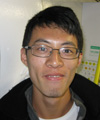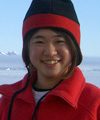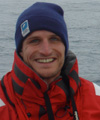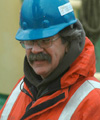Science Team
Primary Project
The science team’s primary goal is to track the currents carrying nutrients and trace metals into the Ross Sea and to study how tiny marine plants (phytoplankton) use these nutrients to grow. Four teams, each specializing in a different piece of the scientific puzzle, work together: the Glider team, led by Josh Kohut, will track the currents, the Phytoplankton team, led by Adam Kustka, will study the phytoplankton, the Iron team, led by Chris Measures, will measure the amount of the trace metal iron in the water, and the Particle team, led by Phoebe Lam, will use measurements of the particles in the water to determine where the iron is coming from.
GLIDER TEAM
The Glider Team, led by Dr. Josh Kohut from Rutgers University, will use an autonomous robot called a glider to track very small changes in the water temperature and salinity (saltiness). The temperature and salinity values are like a unique “fingerprint” to identify different water masses. Based on these small changes, the team will be able to tell what type of water is present in the Ross Sea and where it is moving. In this case, the team is looking for a water mass called Modified Circumpolar Deep Water (MCDW). The science team believes that this water, which “upwells” from the depths onto the shallow Ross Sea shelf, carries critical nutrients and trace metals that allow the ecosystem to thrive. The team will use real-time information from the glider scout to determine exactly where the ship will travel, a method called “adaptive sampling.” The team will deploy in two groups: in December, Chip and Clayton will deploy a glider by helicopter in order to get an early picture of the water masses. In January, Josh and Elias will board the Nathaniel B. Palmer with the rest of the science team and continue to deploy gliders to guide the team’s sampling strategy while underway.
PHYTOPLANKTON TEAM
The Phytoplankton team, led by Dr. Adam Kustka from Rutgers University- Newark, will quantify the responses of the phytoplankton to natural variations in Fe supply from different sources (including the modified circumpolar deep water), as well as the response to incubation experiments where the Fe supply is artificially controlled. Dr. Kustka, along with co-PIs Dr. Allen Milligan and Angel White and their groups, will work closely with the other groups to reveal the relationships between Fe supply and the rates of net carbon dioxide fixation (via phytoplankton growth) in the Ross Sea. Dr. Kustka’s group will also utilize high throughput gene sequencing technologies to evaluate the relative importance of individual species of phytoplankton on carbon fixation.
 |
 |
 |
 |
 |
 |
 |
Dr. Adam KustkaRutgers University |
 |
Dr. Allen MilliganOregon State University |
 |
Dr. Angel WhiteOregon State University |
 |
Dr. Cecile MioniUC Santa Cruz |
 |
 |
 |
 |
 |
 |
 |
Ashley New Graduate Student
|
 |
Menglei Chu Graduate Student
|
 |
Lora McGuinnessRutgers University |
 |
Katie Watkins-BrandtOregon State University |
IRON TEAM
The iron team, led by Dr. Chris Measures from the University of Hawai’i, will obtain trace-metal clean water samples using a special rosette system and determine the concentration of the trace elements iron (Fe), aluminium (Al), and manganese (Mn). They expect as a result of this work to be able to map out the state of Fe availability in the area of the cruise and to relate this to the productivity of the phytoplankton in these regions. Additionally by determining a combination of these trace elements in samples collected along the flow path of the Upper Circumpolar Deep Water (UCDW) as it flows on to the shelf of the Ross Sea they hope to be able to determine whether the Fe that is supplied to the surface waters of the region is in this water mass as it enters the system or is added along the way by interaction with the sediments.
 |
 |
 |
 |
 |
 |
 |
Dr. Chris MeasuresProf of Oceanography
|
 |
Dr. Karen SelphResearch Specialist
|
 |
Dr. Mariko HattaPostdoctoral Scholar
|
 |
Maxime GrandGraduate Student
|
PARTICLE TEAM
The Particle Team, led by Dr. Phoebe Lam from the Woods Hole Oceanographic Institution, be collecting marine particles from the water column using battery-powered pumps. These are filtration systems that filter hundreds of liters of seawater through different sized filters. The advantage to this system is that they will have plenty of material to do many types of analyses. Some of the analyses include measurements of particulate trace metal concentrations and particulate iron speciation (chemical form of iron), rare earth elements and isotopes, and particulate organic carbon (POC) concentrations. The particulate trace metal concentrations, chemical speciation, and rare earth elements help to determine the source of iron to iron-replete regions. The POC measurement will help determine the efficiency of carbon transfer to depth in iron-replete compared to iron-deficient regions. Daniel Ohnemus will also do some incubation experiments to see if particulate iron is “bioavailable”, i.e., whether iron in particulate form can be used by microorganisms.
 |
 |
 |
Dr. Phoebe LamAssistant Scientist
|
 |
Dan OhnemusGraduate Student
|
Affiliate Projects
GLIDER CALIBRATION TEAM
A group from the Virginia Institute of Marine Science (VIMS) will be collecting samples to calibrate the sensors on the gliders. This is very important as sensors do not provide an absolute value for physical and chemical variables (like temperature, salinity and dissolved oxygen), but have to be checked closely using samples collected close to the gliders. In addition, we will assist the Rutgers groups by analyzing all cruise samples for chlorophyll, a good indicator of phytoplankton abundance.
 |
 |
 |
Dr. Walker SmithProfessor
|
 |
Xiao LiuGraduate Student
|
PROTIST TEAM
Most protists (microscopic eukaryotes) are characterized as either plants (they carry out photosynthesis) or grazers (they eat). However, a strategy that combines photosynthesis and eating – mixotrophy – is a widespread phenomenon in aquatic systems. Yet the presence of mixotrophs in the Southern Ocean is known only from our own recently accomplished work. Algal groups with known mixotrophic species, notably chrysophytes, haptophytes, prasinophytes and dinoflagellates, are all present and sometimes abundant in Antarctic waters. Furthermore, the factors that limit algal production in the Southern Ocean, including light limitation and a lack of certain nutrients, also can induce eating in mixotroph species. We also recently published data on the distribution of a kleptoplastidic dinoflagellate in Antarctic waters. This organism also combines phototrophy and eating by stealing chloroplasts of the bloom-forming alga, Phaeocystis antarctica. By combining nutritional modes, mixotrophy may offer competitive advantages over pure phototrophs and grazers in the polar marine environment.
The goal of our project is to understand the importance of mixotrophy for the Antarctic food web. In our field investigations of water and ice communities in the Southern Ocean we will study the relative contributions of mixotrophs to photosynthesis and eating by determining the abundances of mixotrophs, their distribution, and how fast and how much they are able to eat. We will also be searching specifically for the chloroplast-stealing dinoflagellate to further establish its distribution and abundance in the Antarctic.
 |
 |
 |
 |
 |
 |
 |
Dr. Becky GastAssociate Scientist
|
 |
Dr. Bob SandersProfessor
|
 |
Dr. Scott Fay Postdoctoral Scholar
|
 |
Elizabeth Halliday Graduate Student
|
CAPE ADARE LONG-TERM MOORINGS
Water masses of the Ross Sea, including MCDW, interact with the cold polar atmosphere, sea ice and glacial ice to produce cold, dense water which spills into the deep ocean to become Antarctic Bottom Water. As the newly formed bottom waters leave the continental shelf of the Ross Sea, they pass Cape Adare. In 2008, we deployed oceanographic instruments on two moorings anchored to the bottom near Cape Adare, to measure the temperature, salinity and current speed and direction of the escaping deep and bottom flows. On this cruise, we will recover these moorings with their three years worth of data. This long time series will give us an unprecedented, detailed record of the Ross Sea components of Antarctic Bottom Water.
 |
 |
Bruce HuberSenior Staff Associate
|
Julius BuseckeGraduate Student
|






